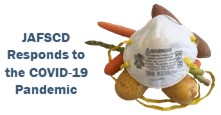Florida Fruit and Vegetable Growers' Adaptation and Response to COVID-19
DOI:
https://doi.org/10.5304/jafscd.2020.094.032
Keywords:
COVID-19, Pandemic, Direct-to-Consumer Sales, Emergency Food Assistance, Cooperative Extension, Food WasteAbstract
While Florida is known for theme parks and beaches, its agricultural sector is the second largest industry in the state and accounts for a substantial proportion of the United States’ annual production of many fruit and vegetable crops. Florida’s farmers have capitalized on the fact that Florida is a top tourism destination, with 70-80% of large producers’ sales targeting the theme-park, hotel, restaurant, and cruise line industries that were decimated by stay-at-home orders. With the exception of citrus, peak harvest for these crops is from March to May, which coincided exactly with the onset of the COVID-19 pandemic in the spring of 2020. Florida producers were left with hundreds of millions of pounds of produce with no available market. Florida farmers utilized innovative sales and market opportunities to sell as much of their highly perishable produce as they could. In addition, despite substantial personal hardship and financial losses, producers paid to harvest and transport produce to food banks and other hunger-relief organizations that were overwhelmed with demand from people who recently lost their jobs or were furloughed due to the closures of restaurants, hotels, theme parks, and cruise lines due to the pandemic. However, with the sheer volume of perishable produce left without buyers, some crops simply had to be tilled under or terminated. The COVID-19 pandemic increased awareness of and demand for Florida agricultural products among Florida residents, leading some grocery stores around the state to commit to buying more produce from Florida growers. A variety of programs and resources to help connect Florida growers to buyers were developed by the University of Florida, Institute of Food and Agricultural Sciences; industry groups; and state and regional organizations. This provides a valuable foundation to support food system resilience for future public health emergencies and natural disasters.
Metrics

Downloads
Published
How to Cite
Issue
Section
Categories
License
Copyright (c) 2020 The Authors

This work is licensed under a Creative Commons Attribution 4.0 International License.
The copyright to all content published in JAFSCD belongs to the author(s). It is licensed as CC BY 4.0. This license determines how you may reprint, copy, distribute, or otherwise share JAFSCD content.












